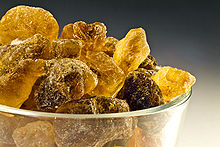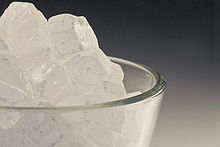Nomenclature:
– Sugar candy originates from Old French “çucre candi” and Arabic “qandi.”
– The term broadened in the United States to refer to any confection with sugar.
– In Britain, “candy” is limited to sweets made from boiled sugar.
– Rock candy in the U.S. refers to large natural sugar crystals, different from British rock.
– Rock candy in the U.S. is considered old-fashioned.
Origins:
– Islamic writers in the 9th century described the production of candy sugar.
– Hafiz Mustafa in Istanbul founded a renowned rock candy maker in 1864.
– Rock sugar is classified into single crystal and polycrystalline types.
– The production process of rock sugar involves growing crystals from supersaturated sugar solutions.
Cuisine:
– Rock candy is dissolved in tea in East Frisia and Iran.
– In China, rock candy is used in chrysanthemum tea and Cantonese dessert soups.
– Rock candy is used in Chinese households for marinating meats and stir-fries.
– In Mexico, rock candy is used to make sugar skulls during the Day of the Dead.
– Rock candy is a common ingredient in Tamil cuisine and Friesland province of the Netherlands.
Misri:
– Misri, originating from South Asia and Iran, refers to crystallized sugar lumps.
– Misri is used in India for making candy and sweetening milk or tea.
– Indian dishes like mishri-mawa and mishri-peda use Misri.
– The Ghantewala Halwai of Delhi is famous for selling sweets made from Misri.
– Misri has medicinal properties and is used in traditional Chinese medicine.
Beverages:
– Rock and rye is a term for alcoholic liqueurs and cocktails using rye whiskey and rock candy.
– Non-alcoholic beverages imitating rock and rye are also popular.
– Faygo produces a Rock & Rye flavored soda pop.
– Rock candy is a common ingredient in various beverages and cocktails.
– The flavor of rock candy complements rye whiskey in many drink recipes.
Rock candy or sugar candy, also called rock sugar, or crystal sugar, is a type of confection composed of relatively large sugar crystals. In some parts of the world, local variations are called Misri, nabat or navat.
 Colored and flavored rock candy commonly sold in the United States | |
| Alternative names | Rock sugar |
|---|---|
| Type | Confectionery |
| Place of origin | Iran |
| Main ingredients | Sugar, water |
| Variations | About 10 |
| 223–400 kcal | |
| Other information | 450–225 |


This candy is formed by allowing a supersaturated solution of sugar and water to crystallize onto a surface suitable for crystal nucleation, such as a string, stick, or plain granulated sugar. Heating the water before adding the sugar allows more sugar to dissolve thus producing larger crystals. Crystals form after six to seven days. Food coloring may be added to the mixture to produce colored candy.
